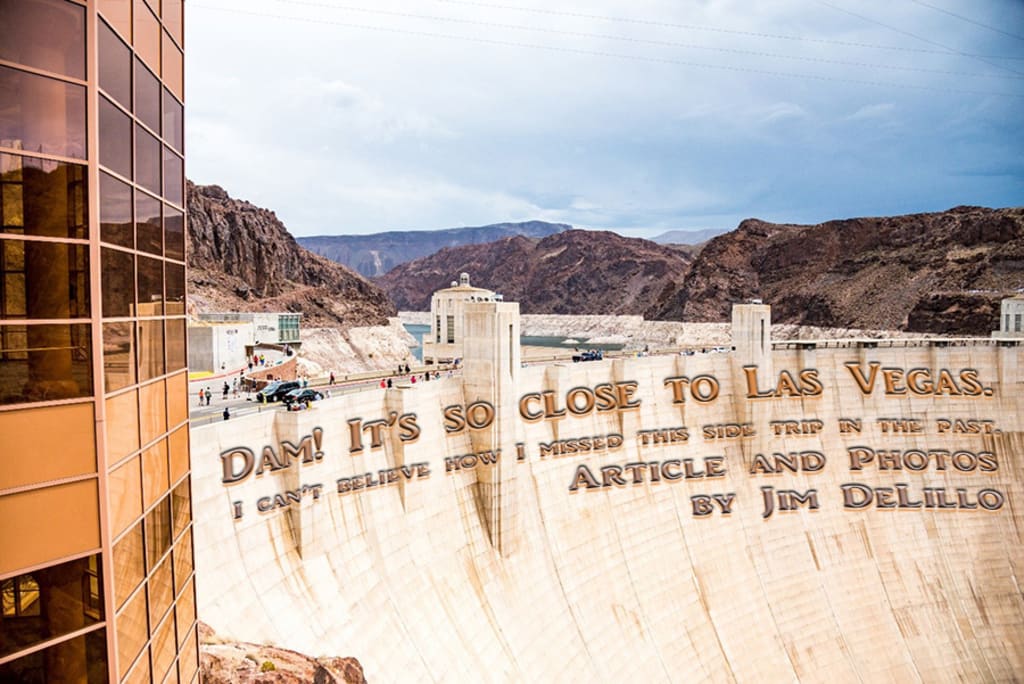Dam! It's So Close To Las Vegas
Visiting the Hoover Dam

Only 35 miles from The Strip, it takes less than one hour to drive there. Boulder Dam, as it was once known, is the result of a government work project that took five years to build, $49 million (1931), $777 million (2016) and twenty-one thousand men. Impressive in its stature, standing 726 feet tall and goes from 660 feet wide at the base to a mere 45 feet wide at the top. Holding back the huge volume of water stored in the reservoir weighs so much that it deformed the earth's crust, causing more than 600 small earthquakes in the late 1930s. The Lake was formed by damming the Colorado River at Black Canyon. The purpose of this is to provide 1.5 million kilowatts of electricity to the surrounding communities in Nevada, Arizona, and southern California.

Don't just drive across the dam. This trip requires you to park your car and walk. The enormity of the construction can only be appreciated by walking along its superstructure and peering down at the river below. The river is bounded by powerhouses and strings of high-tension wires are slung from there to massive pylons. The power is then distributed up the hillside to keep the neon shining in Vegas.
But the real treat is the secret of going inside the dam. This is where the magic happens. A ranger that provides a historical narrative as he guides you into the bowels during the one-hour tour. An elevator drops us to the deep and dungeon-like inner recesses. Once inside, the well-lit and slightly damp tunnels wind their way to where the action is. I'm extremely claustrophobic and had no problem on this visit.

Along the way, I get to peek out of the observation and access ports, and I am reminded of the scene from the movie ‘The Fugitive" with Harrison Ford as he takes a leap of faith and plunges down the sluice.
Venturing deeper into its core, I finally reach the belly of the beast. The room hums with the energy being created. A row of blue turbines topped with beacons indicating when they are running. Each turbine houses large coils to generate electricity. The coils are massive and dwarf the men and equipment used to change them out for maintenance.
To get my pictures in the darkened interior, I bump my ISO to 6400 and find a place to rest my camera against… a railing, or vertically on a wall, the steps of a ladder.

We make our way up ladders and alleys and emerge at the top of the dam.
From the top, I inspect the intakes, huge cylindrical towers with vertical channels rising 395 feet out of Lake Mead. Here is where the water comes in to drive the turbines. The water level is low this year and has been that way for several years. It is at almost 1080 feet, but that is well below the full level of 1225 feet. If the water level drops below 1050 feet, the dam would no longer generate power. There are changes set to go into effect in 2017 that would allow the power station to continue to operate below those levels or at 950 feet. If the worst happens, electricity supplied to 29 million people would be in jeopardy.

The top roadway is a large arc spanning the quarter-mile distance between canyon walls. The sidewalks are full of pedestrians, as the dam only allows limited traffic across, most going to the lookouts and parking lots on the other side. I drove across and found out that there is no highway access and turned around.

The dam is very photogenic and is one of the most visited tourist spots in the country. I point my camera at each cardinal point on the compass and come away with beautiful portraits of the massive structure. I can't help but point my lens down into the chasm. I snap on the wide-angle lens for the most coverage. I didn't think up would yield interesting images, but the erector-set steel towers carrying the voltage out to the cities prove a willing subject.
About 1500 feet downstream, there is a bridge. It was built to take traffic bypassing the dam roadway to relieve congestion and weight. It poses in silence for my shutter.

The most interesting feature for me is the "Winged Figures of the Republic," thirty-foot tall bronze sculptures by sculptor Oskar Hansen. Green now with the patina of age, but there is an oddity. The feet and toes have been buffed to a golden sheen by the thousands of passing tourists' touch. Impressive in size and placement, they provide an air of mystery and connection to the supernatural. Around the base of the figures is a star map.
Getting there
The dam is located 30 miles southeast of Las Vegas. Take US Highway 93 to Nevada State Route 172. The dam is on the Nevada-Arizona border.
Visit the Official Hoover Dam website for further information and details.
Previously published in https://www.americanroads.net/hoover_fall_2016.htm
Be sure to read Jim Delillo's other featured stories on Vocal
You can write for Vocal, too– Join Here
About the Creator
Jim DeLillo
Jim DeLillo writes about tech, science, and travel. He is also an adventure photographer specializing in transporting imagery and descriptive narrative.






Comments
There are no comments for this story
Be the first to respond and start the conversation.